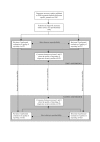Reproducibility of the STARD checklist: an instrument to assess the quality of reporting of diagnostic accuracy studies
- PMID: 16539705
- PMCID: PMC1522016
- DOI: 10.1186/1471-2288-6-12
Reproducibility of the STARD checklist: an instrument to assess the quality of reporting of diagnostic accuracy studies
Abstract
Background: In January 2003, STAndards for the Reporting of Diagnostic accuracy studies (STARD) were published in a number of journals, to improve the quality of reporting in diagnostic accuracy studies. We designed a study to investigate the inter-assessment reproducibility, and intra- and inter-observer reproducibility of the items in the STARD statement.
Methods: Thirty-two diagnostic accuracy studies published in 2000 in medical journals with an impact factor of at least 4 were included. Two reviewers independently evaluated the quality of reporting of these studies using the 25 items of the STARD statement. A consensus evaluation was obtained by discussing and resolving disagreements between reviewers. Almost two years later, the same studies were evaluated by the same reviewers. For each item, percentages agreement and Cohen's kappa between first and second consensus assessments (inter-assessment) were calculated. Intraclass Correlation coefficients (ICC) were calculated to evaluate its reliability.
Results: The overall inter-assessment agreement for all items of the STARD statement was 85% (Cohen's kappa 0.70) and varied from 63% to 100% for individual items. The largest differences between the two assessments were found for the reporting of the rationale of the reference standard (kappa 0.37), number of included participants that underwent tests (kappa 0.28), distribution of the severity of the disease (kappa 0.23), a cross tabulation of the results of the index test by the results of the reference standard (kappa 0.33) and how indeterminate results, missing data and outliers were handled (kappa 0.25). Within and between reviewers, also large differences were observed for these items. The inter-assessment reliability of the STARD checklist was satisfactory (ICC = 0.79 [95% CI: 0.62 to 0.89]).
Conclusion: Although the overall reproducibility of the quality of reporting on diagnostic accuracy studies using the STARD statement was found to be good, substantial disagreements were found for specific items. These disagreements were not so much caused by differences in interpretation of the items by the reviewers but rather by difficulties in assessing the reporting of these items due to lack of clarity within the articles. Including a flow diagram in all reports on diagnostic accuracy studies would be very helpful in reducing confusion between readers and among reviewers.
Figures


Similar articles
-
The quality of diagnostic accuracy studies since the STARD statement: has it improved?Neurology. 2006 Sep 12;67(5):792-7. doi: 10.1212/01.wnl.0000238386.41398.30. Neurology. 2006. PMID: 16966539
-
Quality of reporting of diagnostic accuracy studies.Radiology. 2005 May;235(2):347-53. doi: 10.1148/radiol.2352040507. Epub 2005 Mar 15. Radiology. 2005. PMID: 15770041
-
Quality of reporting of test accuracy studies in reproductive medicine: impact of the Standards for Reporting of Diagnostic Accuracy (STARD) initiative.Fertil Steril. 2006 Nov;86(5):1321-9. doi: 10.1016/j.fertnstert.2006.03.050. Epub 2006 Sep 14. Fertil Steril. 2006. PMID: 16978620
-
Towards complete and accurate reporting of studies of diagnostic accuracy: the STARD initiative.AJR Am J Roentgenol. 2003 Jul;181(1):51-5. doi: 10.2214/ajr.181.1.1810051. AJR Am J Roentgenol. 2003. PMID: 12818829 Review.
-
Towards complete and accurate reporting of studies of diagnostic accuracy: The STARD Initiative.Radiology. 2003 Jan;226(1):24-8. doi: 10.1148/radiol.2261021292. Radiology. 2003. PMID: 12511664 Review.
Cited by
-
Selection and presentation of imaging figures in the medical literature.PLoS One. 2010 May 28;5(5):e10888. doi: 10.1371/journal.pone.0010888. PLoS One. 2010. PMID: 20526360 Free PMC article.
-
Antibody-based detection tests for the diagnosis of Helicobacter pylori infection in children: a meta-analysis.PLoS One. 2008;3(11):e3751. doi: 10.1371/journal.pone.0003751. Epub 2008 Nov 18. PLoS One. 2008. PMID: 19015732 Free PMC article.
-
Has the STARD statement improved the quality of reporting of diagnostic accuracy studies published in European Radiology?Eur Radiol. 2023 Jan;33(1):97-105. doi: 10.1007/s00330-022-09008-7. Epub 2022 Jul 30. Eur Radiol. 2023. PMID: 35907025 Free PMC article.
-
Quality and reporting of diagnostic accuracy studies in TB, HIV and malaria: evaluation using QUADAS and STARD standards.PLoS One. 2009 Nov 13;4(11):e7753. doi: 10.1371/journal.pone.0007753. PLoS One. 2009. PMID: 19915664 Free PMC article.
-
Inter-rater agreement and reliability of the COSMIN (COnsensus-based Standards for the selection of health status Measurement Instruments) checklist.BMC Med Res Methodol. 2010 Sep 22;10:82. doi: 10.1186/1471-2288-10-82. BMC Med Res Methodol. 2010. PMID: 20860789 Free PMC article.
References
Publication types
MeSH terms
LinkOut - more resources
Full Text Sources

